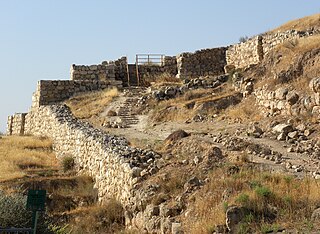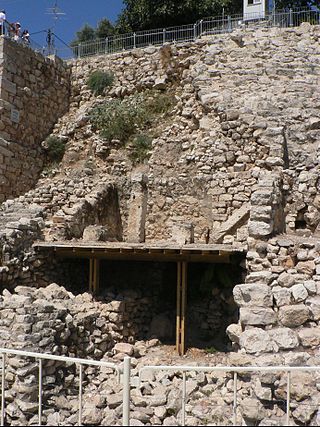
Ahab was the son and successor of King Omri and the husband of Jezebel of Sidon according to the Hebrew Bible. He was widely criticized for causing "moral decline" in Israel, according to the Yahwists. Modern scholars argue that Ahab was a Yahwist and introduced Yahweh to the Kingdom of Judah via imperialism. This mostly occurred in the latter half of his reign.

Jehu was the tenth king of the northern Kingdom of Israel since Jeroboam I, noted for exterminating the house of Ahab. He was the son of Jehoshaphat, grandson of Nimshi, and possibly great-grandson of Omri, although the latter notion is not supported by the biblical text. His reign lasted 28 years.

The Kingdom of Judah was an Israelite kingdom of the Southern Levant during the Iron Age. Centered in the highlands to the west of the Dead Sea, the kingdom's capital was Jerusalem. It was ruled by the Davidic line for four centuries. Jews are named after Judah, and primarily descend from people who lived in the region.

The Kingdom of Israel, Northern Kingdom or Kingdom of Samaria, was an Israelite kingdom in the Southern Levant during the Iron Age, whose beginnings can be dated back to the first half of the 10th century BCE. The kingdom controlled the areas of Samaria, Galilee and parts of Transjordan. The regions of Samaria and Galilee underwent a period with large number of settlements during the 10th century BCE, with the capital in Shechem, and then in Tirzah. The kingdom was ruled by the Omride dynasty in the 9th century BCE, whose political center was the city of Samaria.

Naboth was a citizen of Jezreel. According to the Book of Kings in the Hebrew Bible, he was executed by Jezebel, the queen of Israel, so that her husband Ahab could possess his vineyard.

Lachish was an ancient Israelite city in the Shephelah region of Canaan on the south bank of the Lakhish River mentioned several times in the Hebrew Bible. The current tell by that name, known as Tel Lachish or Tell el-Duweir, has been identified with Lachish. Today, it is an Israeli national park operated and maintained by the Israel Nature and Parks Authority. It lies near the present-day moshav of Lakhish, which was named in honor of the ancient city.

Tel Megiddo, is the site of the ancient city of Megiddo, the remains of which form a tell or archaeological mound, situated in northern Israel at the western edge of the Jezreel Valley about 30 kilometres (19 mi) southeast of Haifa near the depopulated Palestinian town of Lajjun and subsequently Kibbutz Megiddo. Megiddo is known for its historical, geographical, and theological importance, especially under its Greek name Armageddon. During the Bronze Age, Megiddo was an important Canaanite city-state. During the Iron Age, it was a royal city in the Kingdom of Israel.

Israel Finkelstein is an Israeli archaeologist, professor emeritus at Tel Aviv University and the head of the School of Archaeology and Maritime Cultures at the University of Haifa. Finkelstein is active in the archaeology of the Levant and is an applicant of archaeological data in reconstructing biblical history. Finkelstein is the current excavator of Megiddo, a key site for the study of the Bronze and Iron Ages in the Levant.

David Ussishkin is an Israeli archaeologist and professor emeritus of archaeology.

Legio was a Roman military camp south of Tel Megiddo in the Roman province of Galilee.

The Stepped Stone Structure is the name given to the remains at a particular archaeological site on the eastern side of the City of David, the oldest part of Jerusalem. The curved, 60-foot-high (18 m), narrow stone structure is built over a series of terraces. A casemate wall adjoins the structure from a northerly direction at the upper levels, and may have been the original city wall.

The siege of Lachish was the Neo-Assyrian Empire's siege and conquest of the town of Lachish in 701 BCE. The siege is documented in several sources including the Hebrew Bible, Assyrian documents and in the Lachish relief, a well-preserved series of reliefs which once decorated the Assyrian king Sennacherib's palace at Nineveh.

Ze'ev Herzog is an Israeli archeologist, professor of archaeology at The Department of Archaeology and Ancient Near Eastern Cultures at Tel Aviv University specializing in social archaeology, ancient architecture and field archaeology. Ze’ev Herzog served as director of The Sonia and Marco Nadler Institute of Archaeology from 2005 to 2010, and has served as archaeological advisor to the Israel Nature and National Parks Protection Authority in the preservation and development of National Parks at Arad and Beersheba.

Samaria was the capital city of the Kingdom of Israel between c. 880 BCE and c. 720 BCE. It is the namesake of Samaria, a historical region bounded by Judea to the south and by Galilee to the north. After the Assyrian conquest of Israel, Samaria was annexed by the Neo-Assyrian Empire and continued as an administrative centre. It retained this status in the Neo-Babylonian Empire and the Achaemenid Persian Empire before being destroyed during the Wars of Alexander the Great. Later, under the hegemony of the Roman Republic and the subsequent Roman Empire, the city was rebuilt and expanded by the Jewish king Herod the Great, who also fortified it and renamed it "Sebastia" in honour of the Roman emperor Augustus.
Avi Gopher is an Israeli archaeologist. He is a professor at the University of Tel Aviv.
Tell el-Qudeirat is an archaeological site in the Sinai, about 5 mi (8.0 km) east of the Egyptian village of Quseima. It is widely considered to be the location of the biblical Kadesh Barnea. Recently, some authors have referred to it as Tel Kadesh-barnea. Moshe Dothan (1965) referred to it as Tel 'Ein el Qudeirat, while in the early twentieth century Woolley and Lawrence used the spelling Tell Ain el Guderat.

2 Kings 10 is the tenth chapter of the second part of the Books of Kings in the Hebrew Bible or the Second Book of Kings in the Old Testament of the Christian Bible. The book is a compilation of various annals recording the acts of the kings of Israel and Judah by a Deuteronomic compiler in the seventh century BCE, with a supplement added in the sixth century BCE. This chapter records Jehu's massacres of the sons of Ahab, the kinsmen of Ahaziah the king of Judah and the Baal worshippers linked to Jezebel. The narrative is a part of a major section 2 Kings 9:1–15:12 covering the period of Jehu's dynasty.

1 Kings 21 is the 21st chapter of the Books of Kings in the Hebrew Bible or the First Book of Kings in the Old Testament of the Christian Bible. The book is a compilation of various annals recording the acts of the kings of Israel and Judah by a Deuteronomic compiler in the seventh century BCE, with a supplement added in the sixth century BCE. This chapter belongs to the section comprising 1 Kings 16:15 to 2 Kings 8:29 which documents the period of the Omrides. The focus of this chapter is the reign of king Ahab in the northern kingdom.
The Jezreel Valley Regional Project is a long-tem Archaeological survey excavation project exploring the Jezreel Valley, in the southern Levant the Prehistoric through the Ottoman and British Mandate periods in Israel/Palestine.



















